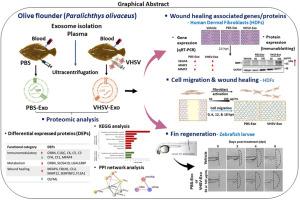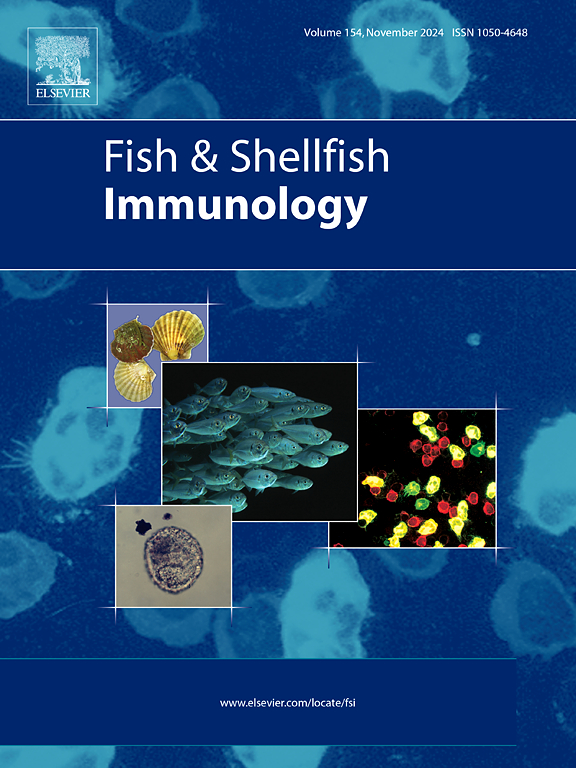病毒性出血性败血症病毒感染橄榄比目鱼的血浆外泌体:蛋白质组学观察和伤口愈合效果。
IF 3.9
2区 农林科学
Q1 FISHERIES
引用次数: 0
摘要
细胞外囊泡(EVs)或其亚型,如外泌体,是有价值的纳米生物分子,用于免疫治疗、药物输送和诊断目的。淡水和海洋鱼类,包括橄榄比目鱼(橄榄比目鱼),对传染性病毒性出血性败血症病毒(VHSV)高度敏感。在这项研究中,我们旨在通过分析感染初期磷酸缓冲盐水(PBS)注射(PBS- exo)和VHSV攻击(VHSV- exo)橄榄比目鱼血浆源性外泌体的蛋白质组学特征,确定感染如何改变生物学反应。此外,为了突出其独特的成分,我们证明了这种免疫调节多功能生物材料具有伤口愈合作用。为了了解这一点,采用等压标签相对和绝对定量(iTRAQ)和串联质谱方法,鉴定了VHSV-Exo中的差异表达(DE)蛋白。感染VHSV后,共鉴定出2399个独特肽,407个蛋白,其中27个上调,25个下调(q < 0.05)。与模拟感染PBS-Exo相比,VHSV-Exo的DE蛋白质组谱由与代谢、免疫反应和伤口愈合相关的各种重要生物过程组成。一组与感染和病理可能相关的蛋白质和途径可以被认为是早期感染的生物标志物。此外,VHSV-Exo在体外和体内均表现出比PBS-Exo更强的伤口愈合作用。这些结果支持我们展示其多功能特性的目标,并可能改善鱼类健康管理和可持续水产养殖实践。本文章由计算机程序翻译,如有差异,请以英文原文为准。

Plasma exosomes from viral hemorrhagic septicemia virus-infected olive flounder (Paralichthys olivaceus): Proteomic insights and wound healing effects
Extracellular vesicles (EVs) or their subtypes, such as exosomes, are valuable nano-biomolecules for immunotherapeutic, drug delivery, and diagnostic purposes. Freshwater and marine fish, including olive flounder (Paralichthys olivaceus), are highly susceptible to the contagious Viral hemorrhagic septicemia virus (VHSV). In this study, we aimed to determine how infection alters the biological responses by analyzing the proteomic profiles of plasma-derived exosomes from phosphate-buffered saline (PBS) injected (PBS-Exo) and VHSV challenged (VHSV-Exo) olive flounders at the initial stages of infection. Moreover, we demonstrate that this immunomodulatory multifunctional biomaterial possesses wound-healing effects. To understand this, the isobaric tags for relative and absolute quantitation (iTRAQ) and tandem mass spectrometry approach was applied, and differentially expressed (DE) proteins in VHSV-Exo were identified. Following VHSV infection, a total of 2399 unique peptides with 407 proteins, including 27 upregulated and 25 downregulated (q < 0.05), were identified. Compared with mock-infected PBS-Exo, the DE proteome profile of VHSV-Exo is composed of various important biological processes related to metabolic, immune responses, and wound healing. A compiled set of proteins and pathways potentially associated with infection and pathology could be considered as early infectious biomarkers. Furthermore, VHSV-Exo exhibited a stronger wound healing effect than PBS-Exo both in vitro and in vivo. These results support our aim of demonstrating their multifunctional properties to improve fish health management and sustainable aquaculture practices.
求助全文
通过发布文献求助,成功后即可免费获取论文全文。
去求助
来源期刊

Fish & shellfish immunology
农林科学-海洋与淡水生物学
CiteScore
7.50
自引率
19.10%
发文量
750
审稿时长
68 days
期刊介绍:
Fish and Shellfish Immunology rapidly publishes high-quality, peer-refereed contributions in the expanding fields of fish and shellfish immunology. It presents studies on the basic mechanisms of both the specific and non-specific defense systems, the cells, tissues, and humoral factors involved, their dependence on environmental and intrinsic factors, response to pathogens, response to vaccination, and applied studies on the development of specific vaccines for use in the aquaculture industry.
 求助内容:
求助内容: 应助结果提醒方式:
应助结果提醒方式:


